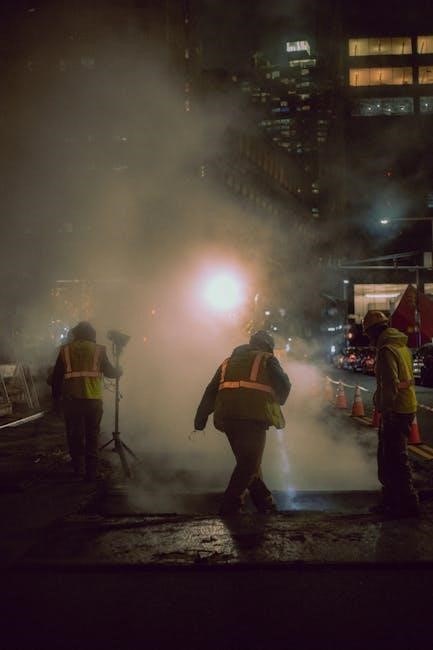The USAR Field Operations Guide (FOG) 2021 is a critical resource for urban search and rescue operations, developed by FEMA’s USAR Technical Sub-committee with USACE.
1.1 Overview of the FOG Manual
The FOG Manual is a comprehensive, pocket-sized guide designed for USAR teams to use during training and missions. It covers essential procedures, structural assessments, and safety protocols, ensuring quick reference in emergencies. Updated in 2021, it incorporates best practices and technical updates, making it an indispensable resource for effective urban search and rescue operations.
1.2 Purpose and Scope of the Guide
The purpose of the FOG Manual is to provide standardized procedures and guidelines for USAR teams during emergencies. Its scope includes operational protocols, safety measures, and technical specifications, ensuring efficient and safe rescue operations. The guide is tailored for urban environments, addressing structural collapses and hazard identification, while adhering to FEMA and USACE standards.
1.3 Target Audience
The FOG Manual is designed for USAR personnel, incident commanders, and structural specialists. It serves as a reference for urban search and rescue teams, providing critical guidance during training and real-world missions. The guide is essential for ensuring operational consistency and adherence to safety protocols among all USAR stakeholders.
Structure and Content of the FOG Manual
The FOG Manual is organized into key sections, including operational procedures, technical specifications, and safety protocols. It provides updated guidance for 2021 to enhance USAR operations.
2.1 Key Sections of the Guide
The FOG Manual includes sections on search and rescue operations, safety measures, communication protocols, and equipment maintenance. It also covers training requirements, emergency response scenarios, and logistical considerations, ensuring comprehensive guidance for USAR teams in 2021.
2.2 Technical Specifications and Updates for 2021
The 2021 FOG Manual introduces updated technical specifications, enhancing operational efficiency. It incorporates improved equipment guidelines, safety protocols, and communication strategies. These updates reflect lessons learned from recent missions and advancements in rescue technology, ensuring USAR teams are better equipped to handle complex scenarios effectively.
Operational Procedures and Protocols
Operational procedures in the 2021 FOG Manual outline standardized practices for USAR missions, emphasizing safety, efficiency, and coordination. These protocols ensure effective execution of search, rescue, and recovery tasks under various emergency conditions.
3.1 Search and Rescue Operations
The FOG Manual details standardized procedures for search and rescue operations, emphasizing rapid assessment of buildings, structural collapse patterns, and hazard identification. Teams utilize advanced techniques for locating survivors, stabilizing structures, and safely extricating individuals. These protocols ensure efficient and safe operations, prioritizing life-saving actions while mitigating risks to rescuers and affected populations.
3.2 Safety Measures and Precautions
The USAR FOG 2021 emphasizes critical safety measures, including the use of personal protective equipment like goggles, masks, gloves, and respiratory protection. Structural assessments and hazard mitigation strategies are detailed to ensure safe operations. Teams are trained to identify potential risks and implement emergency protocols; Effective communication and coordination are stressed to prevent accidents and protect both rescuers and survivors. Adherence to these guidelines is crucial for minimizing risks in rescue environments.
3.3 Communication and Coordination
Effective communication and coordination are vital in USAR operations. The FOG 2021 outlines clear protocols for radio usage, terminology, and incident command systems. Teams must maintain constant communication to ensure seamless operations. Coordination with local authorities, emergency services, and technical experts enhances response efficiency. Clear and concise messaging prevents misunderstandings, enabling swift decision-making and resource allocation during critical rescue missions.
Equipment and Tools
The FOG 2021 outlines essential equipment for USAR operations, including shoring systems, cutting tools, and communication devices. Proper gear ensures safety and efficiency in rescue tasks.
4.1 Essential Gear for USAR Teams
The FOG 2021 emphasizes essential equipment for USAR teams, including shoring systems, cutting tools, communication devices, and safety gear like helmets and respirators. Teams must carry structural assessment tools and portable lighting to navigate and stabilize environments efficiently during rescue operations. Proper equipment ensures operational readiness and safety in challenging urban search and rescue scenarios.
4.2 Maintenance and Inspection Guidelines
The FOG 2021 outlines rigorous maintenance and inspection protocols to ensure equipment reliability. Regular checks of shoring systems, cutting tools, and communication devices are mandatory. Teams must document inspections and perform timely repairs to maintain operational readiness. Proper maintenance prevents equipment failure, ensuring safety and efficiency during critical urban search and rescue missions. Compliance is essential for team preparedness.

Training and Certification
The FOG 2021 emphasizes structured training programs for USAR teams, including FEMA-required courses and certification processes. Teams must stay updated on the latest protocols and guidelines.
5.1 Required Training Courses
The 2021 FOG manual outlines mandatory training courses for USAR teams, including FEMA’s GPS Awareness Level Course and USACE’s Structures Specialist Training. These courses ensure teams are proficient in rescue operations, structural assessments, and safety protocols, adhering to national standards and best practices for effective emergency response and operational readiness. Proper certification is essential.
5.2 Certification Process for USAR Teams
The certification process for USAR teams involves rigorous training and evaluation. Teams must complete FEMA’s USAR GPS Awareness Course and specialized USACE training. Certification requires passing written exams and field simulations. Teams are evaluated on their ability to execute rescue operations safely and effectively. This process ensures compliance with national standards and readiness for deployment in emergency situations.
Emergency Response Scenarios
The section outlines strategies for responding to urban emergencies, detailing tactics for search and rescue operations and addressing specialized rescue situations in diverse disaster scenarios effectively.
6.1 Urban Search and Rescue Tactics
The FOG manual details proven methods for urban search and rescue, emphasizing rubble navigation, structural assessment, and safe victim extraction. It outlines tactical approaches for managing confined spaces, stabilizing structures, and employing specialized tools. Rescue teams are guided on prioritizing life-saving actions while ensuring operational safety. The manual also covers rapid assessment techniques and resource allocation in dynamic disaster scenarios. Effective communication and coordination are stressed to maximize rescue efficiency and minimize risks, ensuring a structured response to urban emergencies.
6.2 Handling Specialized Rescue Situations
The FOG manual provides detailed protocols for managing complex rescue scenarios, including confined space operations, water rescues, and high-angle recoveries. It emphasizes the use of specialized tools and equipment, such as ropes, pulleys, and breathing apparatuses. Rescue teams are guided on assessing risks, stabilizing environments, and executing precise extraction techniques. The guide also covers strategies for managing multiple casualties and coordinating with other emergency services to ensure efficient and safe operations in challenging conditions.

Logistical and Administrative Considerations
The FOG manual outlines resource management strategies, documentation protocols, and administrative procedures to ensure efficient operations. It emphasizes coordination, planning, and compliance with established guidelines for USAR teams.
7.1 Resource Management
The FOG manual emphasizes efficient resource allocation, logistics planning, and equipment maintenance. It provides guidelines for managing supplies, personnel, and tools to ensure operational readiness. Teams are advised to track inventory, optimize resource utilization, and ensure compliance with FEMA standards to maintain effectiveness in rescue operations. Proper resource management is critical for successful mission outcomes.
7.2 Documentation and Reporting
Accurate and thorough documentation is crucial for accountability and legal compliance. The FOG manual outlines standardized reporting protocols, ensuring consistency in data collection and analysis. Teams must maintain detailed records of operations, including resource allocation, incident responses, and personnel actions. Proper documentation supports post-incident reviews, improves future operations, and aligns with FEMA standards for transparency and efficiency.

Legal and Regulatory Framework
The FOG ensures compliance with federal regulations, outlining liability protocols and safety standards. It supports USAR teams in understanding legal obligations and maintaining operational safety.
8.1 Compliance with FEMA Guidelines
The FOG manual ensures adherence to FEMA regulations, providing standardized procedures for USAR operations. It outlines mandatory safety protocols, operational standards, and legal requirements, ensuring teams operate within federal guidelines. Compliance is crucial for maintaining accreditation, liability protection, and effective response capabilities during emergencies. The 2021 updates reflect current regulatory expectations and best practices.
8.2 Liability and Safety Protocols
The FOG manual emphasizes strict adherence to safety protocols to minimize liability risks. It outlines procedures for personal protective equipment, hazard assessments, and emergency response. Compliance ensures operational safety, reduces legal exposure, and protects team members. Safety measures are integral to mission success and team security, as outlined in FEMA and USACE guidelines.
Case Studies and Best Practices
Case studies highlight successful USAR missions, offering insights into effective strategies and lessons learned. Best practices provide practical guidance to enhance operational efficiency and safety.
9.1 Successful USAR Missions
Successful USAR missions demonstrate effective coordination and strategic execution. The FOG 2021 provides critical guidance, enabling teams to navigate complex scenarios efficiently. Real-world applications highlight how adherence to FOG protocols ensures safety and maximizes rescue outcomes, reinforcing its role as an indispensable resource for urban search and rescue operations.
9.2 Lessons Learned and Improvements
The FOG 2021 incorporates lessons from real-world missions, enhancing methodologies. Feedback from USAR teams has led to refined protocols, improving efficiency and safety. Continuous learning and adaptation ensure the guide remains a vital tool for modern rescue challenges, reflecting the evolution of urban search and rescue practices.

Accessing and Utilizing the FOG Manual
The FOG 2021 is available as a downloadable PDF, designed for quick reference. It is easily navigable, ensuring USAR teams can access critical information efficiently during missions.
10.1 How to Download the 2021 PDF Version
The FOG 2021 PDF version is accessible via the official FEMA website. Users can navigate to the publications section, locate the Field Operations Guide, and download it directly. The guide is provided in a portable format, ensuring easy access and quick reference for USAR teams during training and operational scenarios.
10.2 Navigating the Guide for Quick Reference
The FOG 2021 is structured for easy navigation, featuring clear sections and a detailed table of contents. Users can utilize bookmarks and search functions to quickly locate specific topics. The guide also includes quick-reference charts and appendices for rapid access to critical information during missions. Regular updates ensure the manual remains relevant and user-friendly for all USAR operations.
The USAR FOG 2021 concludes as a vital resource, developed collaboratively by FEMA and USACE, with future updates ensuring continued relevance and effectiveness in USAR operations.
11.1 Importance of Staying Updated
Staying updated with the latest versions of the USAR FOG ensures access to new techniques, technologies, and lessons learned, enhancing operational efficiency and safety. Regular updates reflect evolving standards and best practices, ensuring USAR teams remain prepared for diverse rescue scenarios. Teams must monitor official FEMA and USACE publications for the most current guidelines and resources.
11.2 Anticipated Changes in Future Editions
Future editions of the FOG are expected to incorporate advancements in technology, updated safety protocols, and new methodologies. Expanded sections on emerging challenges like climate-related disasters and complex urban rescues are anticipated. Additionally, more integrated digital tools and enhanced training modules will likely be included to support USAR teams in dynamic operational environments;

